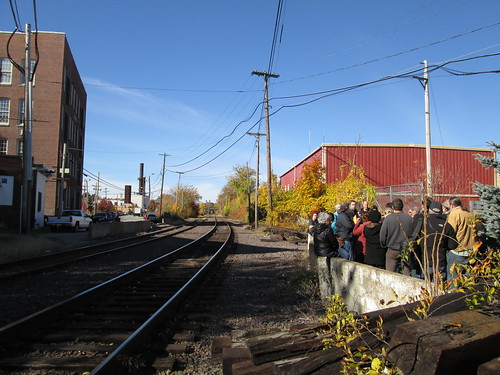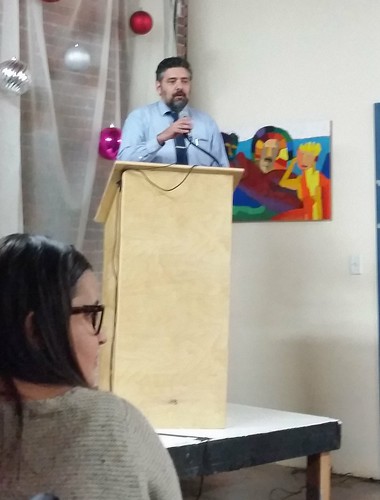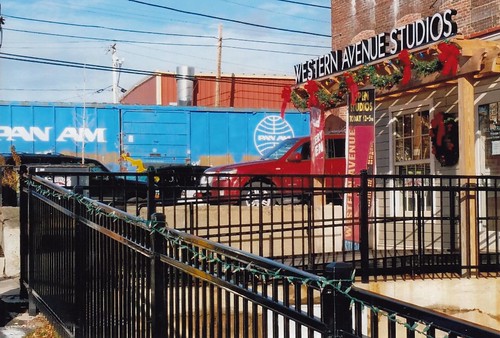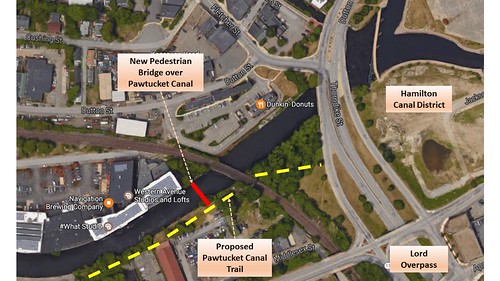Lowell Week in Review: December 11, 2016

Western Ave Studios on left. Rear of Dutton St Dunkin Donuts parking lot on right. Train tracks in the middle.
Western Avenue Access
Thursday night I attended a presentation at Western Avenue Studios by members of Lowell’s Division of Planning and Development, led by DPD Director and Assistant City Manager Diane Tradd, to update the public on efforts to connect Western Ave to Dutton and Thorndike Streets. Historically, the roads did connect, but when the Lord Overpass was constructed in the early 1960s, that end of Western Ave was blocked. However, in the 1980s when the School Street bridge was destroyed by fire and took ten years to repair, the city was able to reopen the Dutton Street end of Western Ave. When the School Street bridge finally re-opened in 1996, Western Ave was closed again, despite the objections of some local business owners. The road has been closed ever since.
The primary reason that Western Ave remains closed at Dutton Street is that it is bisected by twin railroad tracks that are still used by trains. City traffic engineer Nicolas Bosonetto explained that since the majority of train versus car accidents occur at grade crossings, federal and state policy is to eliminate the active crossings that already exist, so the likelihood of anyone allowing the city to create a new “at grade” crossing on Western Ave is nearly non-existent. (The reasons for avoiding at grade crossings were illustrated by a story in yesterday’s Boston Globe – “Woman seriously injured after train strikes car in Belmont.”)

Lowell Traffic Engineer Nicholas Bosonetto
Explaining the physics of moving train, even one traveling just a few miles per hour – its enormous weight prevents it from stopping quickly – Bonsonetto made it clear that an at grade crossing just for pedestrians would not be permitted, either. (He also repeatedly made the point that the people who now cross the tracks on foot are taking enormous risks, especially those who cross by scooting underneath “parked” trains which could begin moving at any time).

Train parked alongside Western Ave
As for whether that train track has any utility beyond its value as real estate, Bonsonetto explained that the tracks along Western Ave are used to assemble trains, which is a complex and time-consuming operation of jockeying loaded freight cars into position. He also said that the long hoped-for commuter rail link between Lowell and Nashua would utilize this stretch of track. As an advocate of better public transportation, I’m all for that commuter rail extension and understand that a new at grade crossing of Western Ave would be an impediment to that.
Until Thursday night, I was an advocate for a pedestrian crossing at grade, but the DPD presentation made it clear to me that such a crossing is just not feasible. Pursuing it further would be a waste of time.
But connecting Western Ave to the Hamilton Canal District remains crucial to the economic development of that entire section of Lowell, so what other options exist? That brought us to a discussion of an elevated walkway over the train tracks. Because of the (commendable) requirements of the Americans With Disabilities Act, such a structure would require elevators at both ends, making it an extremely costly project (preliminary estimates are $5mil plus). Besides the high cost, I don’t believe such a structure would work very well. A better option might be a long, snaking, concrete structure that bridged not only the train tracks, but Thorndike Street as well. I’m thinking of something like Chicago’s Millennium Park Bridge. But as we witnessed in the River Meadow Brook Trail debate, until we can convince some in leadership positions in this city that walking trails are more than “expensive amenities,” something like the Chicago structure could never be built in Lowell.

Chicago’s Millennium Park pedestrian bridge
So where does that leave us? The best option might be a separate and unrelated plan quietly being advanced by Lowell National Park for a Pawtucket Canal walking trail. This pathway would follow the Pawtucket Canal from the Merrimack River, through the Acre, and end at the Swamp Locks within the Hamilton Canal District. To date, there is no funding for this pathway, so it is still only in the concept phase. True, this pathway would go past Western Avenue Studios on the other side of the Pawtucket Canal, but a simple pedestrian bridge over the canal at that point would be much more affordable than an elevated structure over the railway. In fact, a much longer pedestrian bridge that would cross the mouth of the Concord River from Mass Mills to the Lowell Memorial Auditorium is in the cost estimate stage with initial estimates in a more affordable $1mil range.

Pawtucket Canal Walkway with pedestrian bridge from Western Ave over Pawtucket Canal.
The proposed Pawtucket Canal Walking Trail would still have to get across the train tracks, but the tracks on that side of the canal are actually about four feet above the adjacent canal bank which would make tunneling under the track quite feasible. Because the path could be sloped at a gradual enough incline on both sides of the track, ADA compliance would be much easier and affordable.
Of all the Western Ave options reviewed thus far, this pedestrian bridge across the Pawtucket Canal with a pathway passing under the train tracks and ending at Thorndike Street is the best possibility. It is feasible, affordable, and desirable, and we should all start advocating for it.
In the meantime, one of the artists at the meeting suggested that the city should work with the Lowell Regional Transit Authority to create a First Saturday Arts Loop that would run a bus from Gallagher Terminal, to Western Avenue Studios, to Market Street, to Mill No. 5, and then back to the terminal continuously (at no cost to riders) on the first Saturdays of each month, when most of Lowell’s major arts venues on the day they are at their peak of activity. This is such an obvious benefit that I’m wondering why it has not already been done. Hopefully the city will make it happen quickly to help mitigate the relative isolation of the hundreds of small businesses at Western Ave Studios from the rest of downtown Lowell.
Lord Overpass Update
Last March at a public meeting at the Lowell Senior Center, city planners unveiled a startling new proposal to fill in the Lord Overpass and completely redo that complex, hostile-to-pedestrians intersection. There has been little public discussion about the project since then, although about six weeks ago, City Manager Kevin Murphy was quoted in a newspaper story about the widening of Thorndike Street to accommodate the Thorndike Exchange development as saying that filling-in the Lord Overpass was no longer feasible.
Thursday night at the Western Ave discussion, DPD members mentioned that their department, Mass Highway, and associated consultants have been hard at work on the final plan for the Lord Overpass, although they could not tell us what that plan will be. They must first present it to the city council which will happen at a subcommittee meeting on January 10, 2017, just before the regular council meeting. Sometime after that, there will be a public meeting to discuss this proposal, whatever it might be.
New Lowell High School
Earlier this week, Mayor Ed Kennedy talked with Chris Scott on the LTC/Lowell Sun “Sun Spot” weekly news segment. Scott summarized the discussion in a blog post, but I watched a replay of the video interview and provide the following synopsis:
Mayor Kennedy stated that the final “public input” meeting of this process was scheduled for last Thursday night (December 8, 2016) at the Lowell High School auditorium, although before any public money could be spent on this project, there would have to be a public hearing before the City Council. Regarding the recent cost estimates that came in higher than expected, Kennedy said he was not surprised by the estimate for an entirely new school ($320mil) but he was surprised by the estimate to renovate the existing high school ($200mil). He did caution everyone to wait until the feasibility study is completed early in 2017 before making any decisions based on these early estimates. However, Kennedy does believe that the cost of an entirely new high school might be in the vicinity of $400mil. He says the city is in strong financial shape, but there are many competing interests (other schools, new police station, new DPW complex). Kennedy believes that the curriculum at the high school is more of an attraction than the facility, so he’s focused on updating the curriculum, but he said that the existing facility would still have to be renovated to some extent to accommodate an updated curriculum.
Asked about a downtown location versus Cawley Stadium, Kennedy said leaving it downtown makes more sense, because transporting students to Cawley would be much more complicated than getting them downtown. He said that building the high school at Cawley would also require giving up some of the existing athletic fields.
The purpose of the feasibility study is to give the city as many options as possible. Kennedy recalls that he was on the council in the 1970s when that council voted for the Lowell High addition. He said the initial estimate was $19mil, but not enough councilors would support that. Some items were cut from the plan, the estimate dropped to $16mil, and it gained the needed six votes from the council. However, that “new” building, which opened in 1980, is in far worse shape today than the Kirk Street buildings that were constructed nearly a century ago.
In the closing seconds of the segment, Kennedy mentioned that Somerville had just held a ballot referendum in which it asked citizens to authorize a “debt exclusion” measure that would allow the city to add the cost of the new high school to existing property tax bills (it passed in Somerville). He thought a similar ballot question might be appropriate for Lowell.
While Mayor Kennedy seemed to be speaking specifically about a binding debt exclusion ballot question for Lowell, one of his colleagues has a motion on this week’s council agenda for a different kind of ballot question. This motion, by Councilor Corey Belanger, asks about the feasibility of a non-binding “new high school” referendum question that would appear on the 2017 city council ballot. This would allow voters to share their opinion of whether the city should go forward with the specific proposal that had emerged by that time. While the outcome of such a question would not be binding on councilors, it would undoubtedly influence how they would vote on the proposal.
Having such a question on the ballot at city council election time could lead to some interesting and unintended consequences. Right now, there does not appear to be a broad, well-organized, and vocal constituency for a new high school. However, that might change once a specific proposal comes into focus. Those who would be most supportive of a new high school might not be among the 10,000 people who routinely vote in city elections. Adding a high school referendum to the ballot could draw to the polls a number of citizens who do not normally vote in city elections. Since city elections are such low-turnout affairs, adding 1000 or so new voters to the totals might destabilize the traditional power structure. Or it might not. Still, it’s interesting to speculate.
Lowell School Committee
Amy Bisson provides an excellent report on last week’s Lowell School Committee on her blog, “An Educator’s Journey.”
Dining and Shopping in Downtown Lowell
Chris and Aurora, on their Learning Lowell blog, have a recent post about the City of Lights hot chocolate competition, which also serves as a handy survey of many downtown dining establishments. The same post goes on to describe many downtown retail establishments. Check out the blog post, and please shop locally whenever you can.
Winter Weather Advisory
The one-inch snow fall we experienced last week caused considerable traffic disruption. Today’s forecast calls for snow to begin falling by 7pm tonight and continuing until noon tomorrow, with 3 to 6 inches of snow changing to freezing rain likely.
Marijuana Legal on Thursday
This Thursday, December 15, 2016, is the day marijuana use becomes legal in Massachusetts, per the successful ballot question in last month’s election (unless the state legislature modifies the law prior to that). Boston Magazine provides a helpful summary of what the law does and does not allow (the following bullet points from the Boston Magazine article):
- It will still be illegal to buy or sell marijuana, or for those under 21 to use it. It is legal, though, to give someone pot for free.
- It will also still be illegal to use the drug in public places, so anyone who wants to partake will have to do it at home (assuming one’s landlord approves).
- The law permits you to possess up to ten ounces in your residence, but only one ounce in public.
- For those hoping to get started growing marijuana, the law allows for 6 plants per person, or 12 plants per household. Also, those plants have to be out of the sight of neighbors (specifically, impossible to see “without the use of binoculars, aircraft or other optical aids”). So, for most people, that means they would have to be indoors.
- Also, the law on possession inside a car is similar to the one for alcohol. It’s illegal to have an “open container” of marijuana in a vehicle, unless it’s stashed in a trunk or in a locked glove box.
- By the way, all those elaborate “tobacco” water pipes you might have seen inside stores while marijuana was illegal? As of Thursday, shopkeepers can start calling them bongs.
I voted No on the referendum, because we are in the midst of a devastating epidemic of opioid and heroin abuse that shows no sign of abating. Even though the science of whether marijuana is a gateway drug to the abuse of more powerful substances, people who I know in the fields of law enforcement, education, and substance abuse treatment, and whose opinions I trust, have told me that it is. So even though it will be legal, I think that out of an abundance of caution, we should still steer clear of marijuana.
I feel that we cannot (and should not) give up on reopening the Western Ave/Dutton St grade crossing. If we do not then it is very possible that in the event of a major fire or other disaster the city could be open to enormous liability. To have 400+ artists and their visitors in a complex with only 1 access/egress point for fire and other public safety vehicles is ludicrous in my opinion. I was told by a now retired inspector that he would never have given a C.O. (certificate of occupancy) for a complex that large with only one way in or out.
As someone who used to work at (then) Joan Fabrics, I definitely agree with Gary’s point. While there have been safety upgrades, it is still a very old building and some of us were afraid of this same thing!
It’s misleading to say filling in the Lord Overpass is no longer feasible yet find funding for building an elevated pedestrian bridge to Sal’s building and widen Thorndike St.
It’s more accurate to say the priorities of political leaders is more about big business(Sal is big for this area) and the swift flow of private automobiles over small business and multi-modal transportation.
The concentration of wealth and power demoralizes people and many lose hope and turn to drugs. https://www.lowellsun.com/todaysheadlines/ci_30642338/deadly-lowell-opioid-ods-outpacing-2015
The dominance of car travel and its related infrastructure bankrupts us so that we can’t afford the basics like painting our elementary school walls and need donations and volunteers. https://www.lowellsun.com/local/ci_30639063/little-bit-fate-eases-repainting-lowell-school
I don’t know how to change the mindset and hope it doesn’t take a severe depression for us to think smarter about how we do things around here.